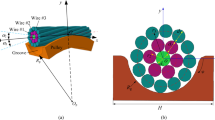Abstract
A new high-voltage electricity wire model is proposed to simulate the dynamic behavior of the wire after tension failure and the nonlinear sliding joints between the wire and the iron tower. A previously developed piecewise cable element based on the absolute nodal coordinate formulation is used with its computer implementation given in this paper. In order to describe the initial tension in the wire, a static solving approach is used to achieve equilibrium between the element elastic force and the external force including the tension. The obtained configuration of the wire is then used as the initial configuration of analysis in case of unloaded external tension force. Thereby, the dynamic behavior of the wire can be modeled. The sliding joint constraint is used to describe the motion of the wire going through the iron tower after tension failure. A new static solution approach is developed to avoid the sliding joint constraint violation in the resulting equilibrium configuration. The convergence of the piecewise cable element based on the absolute nodal coordinate formulation is tested. A set of comparative results is presented to demonstrate the feasibility of the method proposed in this investigation.
Similar content being viewed by others
References
Gerstmayr, J., Shabana, A.A.: Analysis of thin beams and cables using the absolute nodal co-ordinate formulation. Nonlinear Dyn. 45, 109–130 (2006)
Hong, D., Ren, G.: A modeling of sliding joint on one-dimensional flexible medium. Multibody Syst. Dyn. 26, 91–106 (2011)
Escalona, J.L.: An arbitrary Lagrangian-Eulerian discretization method for modeling and simulation of reeving systems in multibody dynamics. Mech. Mach Theory 112, 1–21 (2017)
Seo, J.-H., Sugiyama, H., Shabana, A.A.: Three-dimensional large deformation analysis of the multibody pantograph/catenary systems. Nonlinear Dyn. 42, 199–215 (2005)
Seo, J.-H., Kim, S.-W., Jung, I.-H., Park, T.-W., Mok, J.-Y., Kim, Y.-G., Chai, J.-B.: Dynamic analysis of a pantograph-catenary system using absolute nodal coordinates. Veh. Syst. Dyn. 44, 615–630 (2006)
Pappalardo, C.M., Patel, M.D., Tinsley, B., Shabana, A.A.: Contact force control in multibody pantograph/catenary systems. Proc. Inst. Mech. Eng. Part K J. Multi-body Dyn. 230, 307–328 (2016)
Carnicero, A., Jimenez-Octavio, J.R., Sanchez-Rebollo, C., Ramos, A., Such, M.: Influence of track irregularities in the catenary-pantograph dynamic interaction. J. Comput. Nonlinear Dyn. 7, 041015 (2012)
Lan, P., Shabana, A.A.: Integration of B-spline geometry and ANCF finite element analysis. Nonlinear Dyn. 61, 193–206 (2010)
Piegl, L., Tiller, W.: The NURBS Book. Springer, New York (2012)
Lan, P., Yu, Z., Du, L., Lu, N.: Integration of non-uniform rational B-splines geometry and rational absolute nodal coordinates formulation finite element analysis. Acta Mech Solida Sin. 27, 486–495 (2014)
Sanborn, G.G., Shabana, A.A.: A rational finite element method based on the absolute nodal coordinate formulation. Nonlinear Dyn. 58, 565–572 (2009)
Nada, A.A.: Use of B-spline surface to model large-deformation continuum plates: procedure and applications. Nonlinear Dyn. 72, 243–263 (2013)
Yu, Z., Lan, P., Lu, N.: A piecewise beam element based on absolute nodal coordinate formulation. Nonlinear Dyn. 77, 1–15 (2014)
Sugiyama, H., Escalona, J.L., Shabana, A.A.: Formulation of three-dimensional joint constraints using the absolute nodal coordinates. Nonlinear Dyn. 31, 167–195 (2003)
Gerstmayr, J.: Nonlinear constraints in the absolute coordinate formulation. Acta Mech. 192, 191–211 (2007)
Sugiyama, H., Yamashita, H.: Spatial joint constraints for the absolute nodal coordinate formulation using the non-generalized intermediate coordinates. Multibody Syst Dyn. 26, 15–36 (2011)
Wallin, M., Aboubakr, A.K., Jayakumar, P., Letherwood, M.D., Gorsich, D.J., Hamed, A., Shabana, A.A.: A comparative study of joint formulations: application to multibody system tracked vehicles. Nonlinear Dyn. 74, 783–800 (2013)
Mizuno, Y., Sugiyama, H.: Sliding and nonsliding joint constraints of B-spline plate elements for integration with flexible multibody dynamics simulation. J Comput. Nonlinear Dyn. 9, 011001 (2013)
Shabana, A.A., Yakoub, R.Y.: Three dimensional absolute nodal coordinate formulation for beam elements: theory. J. Mech. Des. 123, 606–613 (2001)
Yakoub, R.Y., Shabana, A.A.: Three dimensional absolute nodal coordinate formulation for beam elements: implementation and applications. J. Mech. Des. 123, 614–621 (2001)
Mikkola, A.M., Shabana, A.A.: A non-incremental finite element procedure for the analysis of large deformation of plates and shells in mechanical system applications. Multibody Syst. Dyn. 9, 283–309 (2003)
Wei, C., Wang, L., Shabana, A.A.: A total Lagrangian ANCF liquid sloshing approach for multibody system applications. J. Comput. Nonlinear Dyn. 10, 051014 (2015)
Shabana, A.A.: Computational Continuum Mechanics. Cambridge University Press, New York (2012)
Pappalardo, C.M., Yu, Z., Zhang, X., Shabana, A.A.: Rational ANCF thin plate finite element. J. Comput. Nonlinear Dyn. 11, 051009 (2016)
Berzeri, M., Shabana, A.A.: Development of simple models for the elastic forces in the absolute nodal co-ordinate formulation. J. Sound Vib. 235(4), 539–565 (2000)
Gerstmayr, J., Irschik, H.: On the correct representation of bending and axial deformation in the absolute coordinate formulation with an elastic line approach. J. Sound Vib. 318, 461–487 (2008)
Acknowledgements
This research was supported by “the National Natural Science Foundation of China” (Grant No. 11802072) and “the Fundamental Research Funds for the Central Universities” (Grant No. HIT. NSRIF 2018032).
Author information
Authors and Affiliations
Corresponding author
Additional information
Publisher's Note
Springer Nature remains neutral with regard to jurisdictional claims in published maps and institutional affiliations.
Rights and permissions
About this article
Cite this article
Lan, P., Li, K. & Yu, Z. Computer implementation of piecewise cable element based on the absolute nodal coordinate formulation and its application in wire modeling. Acta Mech 230, 1145–1158 (2019). https://doi.org/10.1007/s00707-018-2332-y
Received:
Revised:
Published:
Issue Date:
DOI: https://doi.org/10.1007/s00707-018-2332-y



